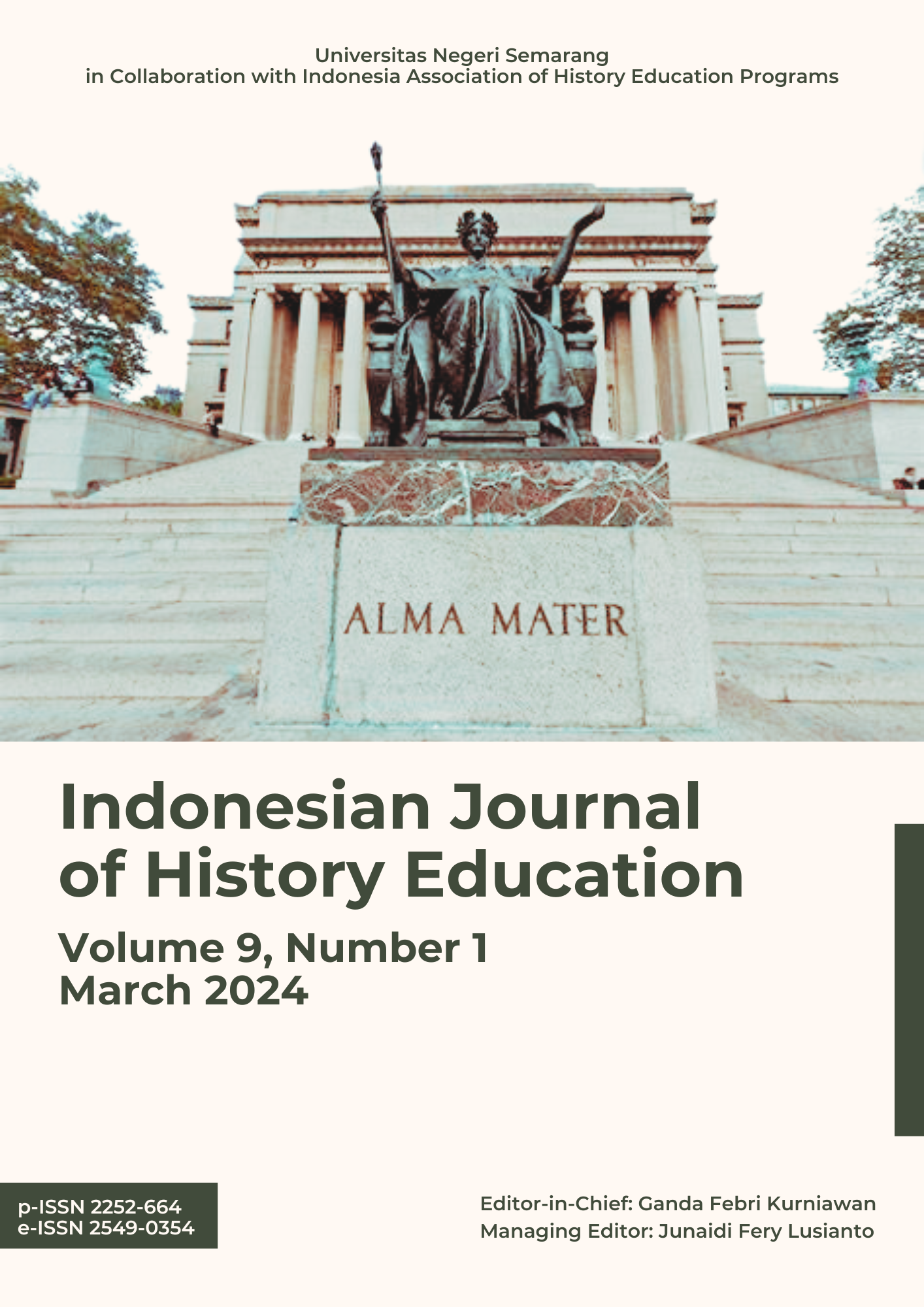Analysis of Final Semester Assessment Question Items for Class XI Indonesian History Subjects
Abstract
This research aims to determine the quality of the final semester assessment (PAS) questions in the Indonesian History subject Class Quantitative analysis is reviewed from the aspects of validity, reliability, level of difficulty, distinguishing power, and effectiveness of distractors. The results of the qualitative analysis of the research showed that the material aspect was met at 96%, the construction aspect at 95.14%, and the language aspect at 73.5%. Judging from the distribution of cognitive domain levels, category (C1) has 7 questions (14%), category (C2) has 35 (70%) questions, category (C3) has 3 questions (6%) and category (C4) has 5 questions (10%). The results of the quantitative analysis of the validity aspect showed that 39 questions (78%) were valid while 11 questions (22%) were invalid. The reliability of the questions is very high at 0.862. From the level of difficulty, 10 (20%) questions were declared difficult, 25 questions (50%) were medium and 15 questions (30%) were easy. Looking at the aspect of differentiating power, there are 6 (12%) questions in the poor category, 7 (14%) questions in the fair category, 26 (52%) questions in the good category, and 9 (18%) questions in the very good category, while the total category is 2 bad. (4%) questions. Judging from the effectiveness of the distractor, the category is very good 21 (42%) questions, functioning well 10 (20%) questions, functioning quite well 10 (20%) questions, functioning poorly 5 (10%) questions, and functioning not well/poorly 4 (8%) questions. Overall, the quality of the questions in terms of quantitative analysis is not good.
References
Ani Syahida, D. I. (2015). Analisis Keterampilan Berpikir Tingkat Tinggi Pada Soal Ujian Nasional Kimia. EduSains, 7(1), 1–23.
Arifin, Z. (2012). Evaluasi Pembelajaram. In Evaluasi Pembelajaran (Direktorat). Direktorat Pendidikan Tinggi Islam Direktorat.
Arikunto, S. (2018). Dasar-Dasar Evaluasi Pendidikan (Edisi 3). Bumi Aksara.
Depdiknas. (2008). Panduan Analisis Butir Soal. Departemen Pendidikan Nasional.
Fitrianawati, M. (2017). Peran Analisis Butir Soal Guna Meningkatkan Kualitas Butir Soal, Kompetensi Guru Dan Hasil Belajar Peserta Didik. JPT : Jurnal Pendidikan Tematik, 2(3), 316–322. http://publikasiilmiah.ums.ac.id/handle/11617/9117
Haryanto. (2020). Evaluasi pembelajaran; konsep dan manajemen. In UNY Press.
Hidayat, R., & Patras, Y. E. (2013). Evaluasi Sistem Pendidikan Nasional Indonesia. International Seminar on Quality and Affordable Education (ISQAE), 2, 79–88.
Kemendikbud. (2003). Undang-undang Republik Indonesia Nomor 20 Tahun 2003 Tentang Sistem Pendidikan Nasional. Menteri Pendidikan Republik Indonesia, 1116/MENKE(1), 1–22. http://dx.doi.org/10.1016/j.gr.2011.06.005%0Ahttp:/
Khaerudin. (2015). Kualitas instrumen hasil belajar. Jurnal Madaniyah, 2, 212–235.
Mitra Prawiki, S., & Helendra. (2021). Analisis Kualitas Butir Soal Ujian Akhir Semester Ganjil Tahun Pelajaran 2020/2021 Mata Pelajaran Biologi Kelas X SMA Negeri 1 Teluk Sebong. Biodidaktika: Jurnal Biologi Dan Pembelajarannya, 17(2), 13–23. http://dx.doi.org/10.30870/biodidaktika.v17i2.16493
Nurohim, A., Bain, & Suryadi, A. (2016). Pelaksanaan Penilaian Autentik dalam Pembelajaran Sejarah Kurikulum 2013 di SMA Negeri 1 Purwareja Klampok Tahun Pelajaran 2015/2016. Indonesian Journal of History Education, 4(2), 2–7. https://docplayer.info/61454299-Indonesian-journal-of-history-education.html
Ofianto. (2018). Analysis Of Instrument Test Of Historical Thinking Skills In Senior High School History Learning With Quest Programs. Indonesian Journal of History Education, 6(2), 184–192.
Pamungkasih, R. S. N., & Nawawi, E. (2021). Analisis Kualitas Butir Soal Ujian Akhir Semester Ganjil pada Mata Pelajaran Kimia Kelas X di SMA Negeri 8 Palembang Tahun Ajaran 2020/2021. Prosiding Seminar Nasional Pendidikan IPA Tahun 2021, 1.
Purwanto, N. (2009). Prinsip-Prinsip dan Teknik Evaluasi Pengajaran. PT Remaja Rosdakarya.
Riinawati. (2021). Pengantar Evaluasi Pendidikan. Thema Publishing.
Sudijono, A. (2006). Pengantar Evaluasi Pendidikan. Rajagrafindo Persada.
Sudjana, N. (2004). Penilaian Hasil Proses Belajar Mengajar. PT Remaja Rosdakarya.
Sukardi. (2012). Evaluasi Pendidikan: Prinsip & Operasionalnya (F. Yustianti (ed.)). Bumi Aksara.
Surapranata, S. (2004). Panduan Penulisan Tes Tertulis Implementasi Kurikulum 2004. PT Remaja Rosdakarya.
Surapranata, S. (2005). Analisis, Validitas, Reabilitas dan Interpretasi Hasil Tes Implementasi Kurikulum 2004 (Cetakan ke). PT Remaja Rosdakarya.
Tim Pusat Penilaian Pendidikan. (2019). PANDUAN PENILAIAN TERTULIS 2019 (Deni Herdiana (ed.); 2019th ed.). Pusat Penilaian Pendidikan Kementerian Pendidikan dan Kebudayaan.
Wardani, S., Setiawan, B., & Hastuti, S. (2020). Pelajaran Bahasa Indonesia Di Sma Language Error Analysis of Indonesian Language. BASASTRA Jurnal Bahasa, Sastra, Dan Pengajarannya, 8(April 2020), 180–194.
Widoyoko, E. P. (2014). Penilaian Hasil Pembelajaran Di Sekolah. Pustaka Pelajar.
Yonelia, V., & Haryati, S. (2014). Analisis Butir Soal Ujian Semester Genap Mata Pelajaran Kimia Kelas X IPA SMA PGRI Pekanbaru Tahun Ajaran 2013/2014. Jurnal Online Mahasiswa Fakultas Keguruan Dan Ilmu Pendidikan Universitas Riau, 2(1), 1–15.
Copyright (c) 2023 IJHE

This work is licensed under a Creative Commons Attribution 4.0 International License.
Copyright Notice
An author who publishes in the Jurnal Indonesian Journal of History Education agrees to the following terms:
- Author retains the copyright and grants the journal the right of first publication of the work simultaneously licensed under the Creative Commons Attribution-ShareAlike 4.0 License that allows others to share the work with an acknowledgement of the work's authorship and initial publication in this journal
- Author is able to enter into separate, additional contractual arrangements for the non-exclusive distribution of the journal's published version of the work (e.g., post it to an institutional repository or publish it in a book) with the acknowledgement of its initial publication in this journal.
- Author is permitted and encouraged to post his/her work online (e.g., in institutional repositories or on their website) prior to and during the submission process, as it can lead to productive exchanges, as well as earlier and greater citation of the published work (See The Effect of Open Access).
Read more about the Creative Commons Attribution-ShareAlike 4.0 Licence here: https://creativecommons.org/licenses/by-sa/4.0/.




